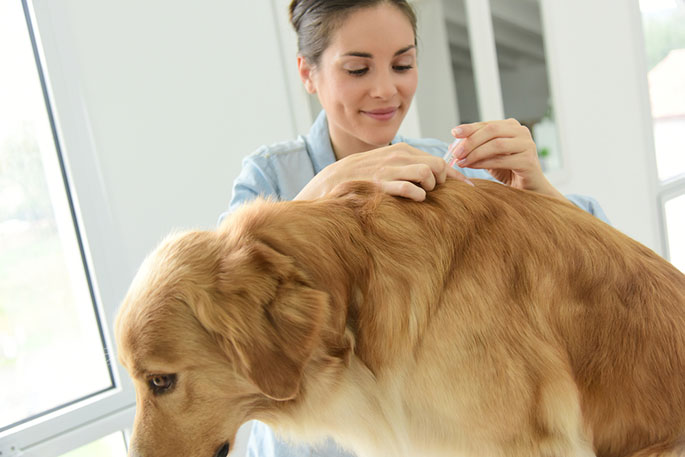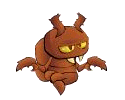
Sometimes we find ourselves in a situation in which our beloved dog gets fleas, and we feel helpless because maybe that it is a weekend where we would get no help instantly or that the veterinarian is far far away and isn’t in our reach.
Nobody wants their dog to have fleas as:
- Dogs can have a bad time scratching,
- They can infect us or worse,
- Fleas may lay eggs at home, and in a few weeks we have a real plague
- And many other severe cases can be witnessed if neglected intentionally
Thus, it becomes the foremost duty of pet owners or pet parents to pay close heed to get rid of fleas and implement some effective ways to avoid witnessing a troublesome situation.
Before diving in, let’s gain some scientific knowledge about fleas and see how they tend to inflict the dogs.
Fleas on Dogs

Fleas are one of the most frequent parasites feeding on dogs. They are small neoptera insects, without wings, but with powerful hind legs that allow them to jump a great distance and height. Fleas feed on the blood of mammals, in this case, dogs and can transmit a wide variety of diseases.
Some Flea Facts
Nobody likes fleas, but we must recognize that they have some peculiarities that make them, at least, curious:
- Fleas have an oral tube mechanism specially adapted to feed on the blood of our dogs, cats, or ours.
- They possess a laterally compressed body, which allows them to swift easily between the dog’s fur coat.
- They can jump up to 200 times their own length: they have the hind legs so adapted for the jump that they can jump up to 18 cm in the vertical direction and 33 cm in the horizontal direction.
Fleas are the best jumper among animals in relation to their body size.
- After feeding on blood, the female flea deposits between 15 and 20 eggs per day up to 600 in its entire life, and does so on the host (in this case the dog). Eggs laid loose in the fur can fall and be deposited on carpets, furniture, sheets, sofa covers, etc.
Apart from these curiosities, it is important to know other characteristics of these parasites in dogs. For example, they are capable of transmitting diseases as serious as typhoid, bubonic plague, or tapeworms.
That is why it is so important to know how to eliminate fleas in dogs because they can be the origin of very serious pathologies.
Fleas are a risk for our dogs, and that is why we must learn to prevent and eliminate them in order to keep our furry companions happy and healthy.
How to Know if Your Dog Has Fleas?
Some symptoms to check whether your pet dog is attacked by fleas or not:
- If you notice that your dog scratches more than the bill, it might have fleas, ticks or fungus on the skin. (It might be that you are unable to see them at first as they are jumping, but you can see their trail.)
- If your dog scratches his neck or ears excessively or even bites them aggressively, then he may have fleas. Moreover, if he is allergic to flea bites, it will present dermatitis and itching will make him scratch, even more, causing skin wounds.
- Look closely at the dog’s fur to confirm your doubts. If you are unable to see them from the naked eye, swipe your finger against it and check for black spots on his skin. If so, then your dog has fleas.
- If there appears some solid dark spots on the skin and hair of your dogs then consider them as flea droppings which is one of the clearest signs.
How to Eliminate Fleas from Dogs?
The most important thing is that when you deal with the issue of fleas, do it with all your animals at once (if you have several pets). In addition, you should treat the environment, beds, booths, sofas, carpets, bedding, upholstery.
The veterinarian will be able to guide you on prevention methods and possible treatments and effective disinfection products. We have several options, the usual ones like using some anti-parasitic products and also home remedies which give proven results.
Chemical Removal
The most common is to protect your pet from these insects with the help of pipettes and/or flea collars. There is a lot of variety in the market, although not every product is equally effective. It is better to invest some money in a good collar or pipette to ensure the good health and comfort of your pet.
You should also keep in mind that not all anti-parasitic collars are suitable. If your dog has sensitive skin, certain collars may cause allergy. In these cases, you will have to focus on the use of pipettes, such as the Frontline Combo Spot-On dog pipette, which prevents your dog from ticks, fleas, mites, and canine lice.
[Prefer Reading: Things to Know before Purchasing Dog Collars.]As a general rule, the effectiveness of pipettes is one month. For its part, a good flea collar can remain effective for 6 to 8 months.
If you realize late that the pet is infested with fleas, it is best to use a specific spray. These insecticidal liquids are very effective. There are also other control methods you should explore.
They have active ingredients capable of eradicating fleas instantly. It will be very easy to deworm the dog with this type of spray. Once the liquid has taken effect, you will have to bathe and brush the dog to remove the bodies.
[NB (Nota Bene): The neck and base of the dog’s tail are the places of concentration of fleas.]Home Remedies
A few tips that can help you with the task of eradicating your pet’s fleas.
#With Lemon
Lemon juice is a natural flea repellent, just squeeze a lemon and mix its juice with half a liter of water and spray (atomize) the mixture on your dog and brush it before it dries. In this way the mixture of lemon juice and water will penetrate all layers of the dog’s hair, causing fleas to leave.
#With Dishwasher
The most effective way to remove fleas from the animal’s fur is to bathe it with hot water and dishwashing detergent. No, you don’t have to put your dog in the sink, much less. Simply mix a couple of cups of hot water with another of alcohol and a few drops of dishwashing soap.
Bathe your dog and use the mixture to rinse it completely, without forgetting the head or ears. Let the mixture act a couple of minutes on the skin and then rinse the animal with plenty of warm water. Finally, brush it thoroughly and remove all the fleas you have.
#With Vinegar
Another option is to smear it with vinegar after bathing. After five minutes soaked in vinegar, the fleas will have died or will be dying. Brush it with a fine comb or nipple and rinse your hair.
Separate the fleas of the fur, introduce them in a closed container with alcohol to avoid that they jump to another place.
These ‘DIY’ (Do It Yourself) techniques will certainly help you to eliminate fleas from your furry pals and can be repeated a few times a week if necessary.



